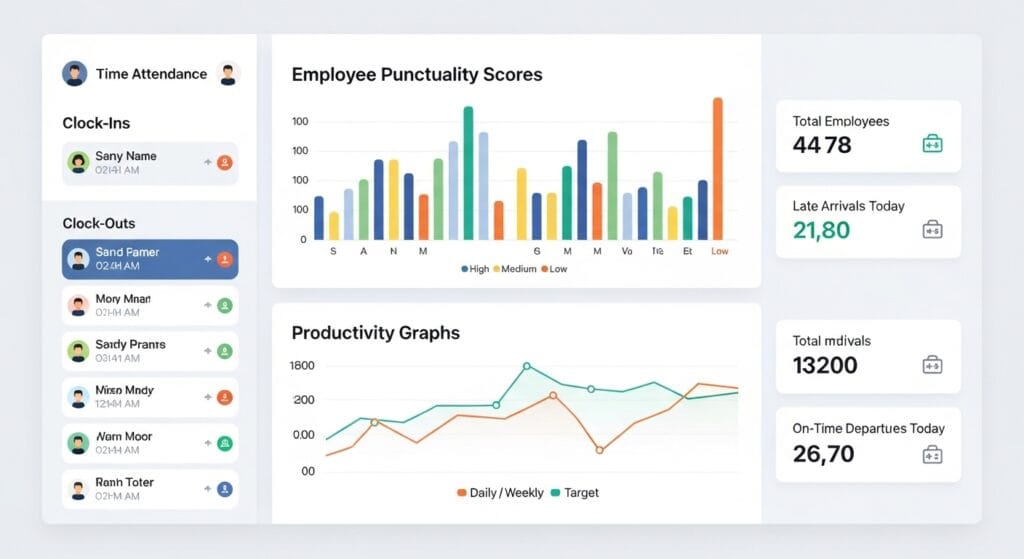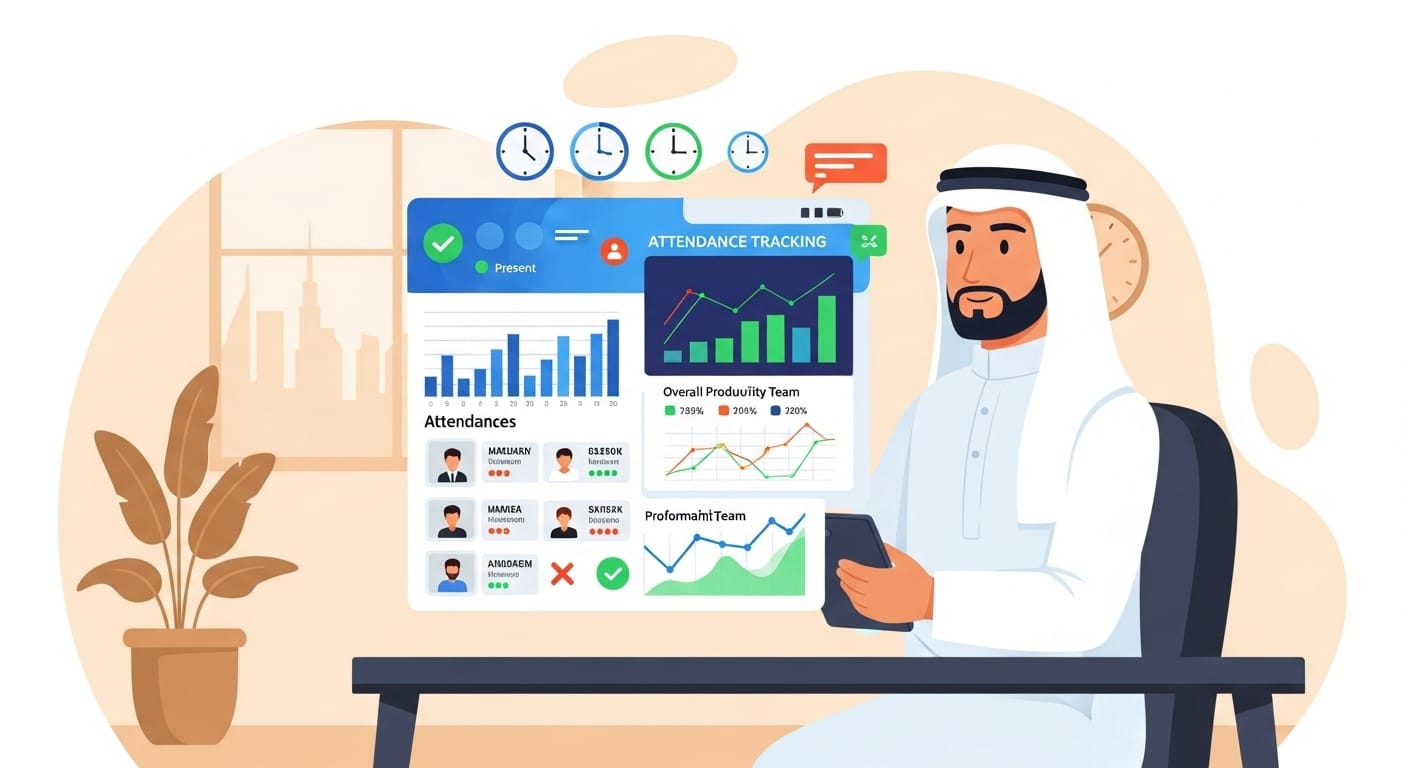In any fast-paced business, time is the one resource you can never get back. Yet, it’s the one most easily lost. A few employees arriving late, extended breaks, “buddy punching,” and the slow, agonizing process of manual payroll—these small “time thefts” add up to a significant drain on your resources. In the competitive landscape of Saudi Arabia, you can no longer afford this inefficiency.
Many managers believe that tracking time is just about “catching” late employees. But this is a dated perspective. A modern Time Attendance System is not a tool of punishment; it’s a strategic asset for building a culture of accountability, ensuring fairness, and—most importantly—unlocking hidden layers of productivity across your entire organization.
This guide explores how upgrading from an old-fashioned sign-in sheet or a basic fingerprint reader to an integrated, modern system can transform your business, all while ensuring full compliance with Saudi Labor Law.
The Old Way: Why Your Manual System is Costing You Money
Let’s be honest: is your current attendance “system” truly a system? For many businesses, it’s a patchwork of inefficient tools:
- The Paper Sign-in Sheet: Relies on honesty, is impossible to verify, and requires a dedicated HR employee to manually type every single entry into a spreadsheet.
- The Excel Spreadsheet: Prone to human error, typos, and formula mistakes. A single “fat-finger” error can lead to overpaying one employee and underpaying another.
- The “Buddy Punching” Card: An employee who is running late texts a friend in the office to punch their card in for them. This common practice makes your punctuality data completely unreliable.
- The Basic Fingerprint Reader: A step up, but it’s a “dumb” device. It just stores logs in a file that HR must manually download, clean up, and import into their payroll software. The data is not real-time and the process is still manual.
This “old way” is not just inefficient; it’s a direct drain on profitability. It wastes your HR team’s valuable time on low-value data entry, creates payroll errors that damage employee morale, and gives you zero real-time insight into your actual workforce.
What is a “Modern Time Attendance System”?
A modern Time Attendance System, especially in the context of Saudi Arabia, is a software-centric solution that is integrated, automated, and intelligent. It’s often cloud-based and acts as the central hub for all employee time data.
Its key components include:
- Multiple Data Capture Methods: It’s not one-size-fits-all. It allows employees to check in via advanced biometrics (fingerprint or facial recognition), mobile apps (with geofencing), or secure web portals for remote staff.
- Real-Time Data Sync: The moment an employee clocks in, the data is instantly available to managers and HR on their dashboards.
- Full Automation: The system automatically calculates total hours, breaks, and, most importantly, overtime based on your specific rules.
- Direct Integration: This is the most critical part. The system “talks” directly to your HRMS (Human Resources Management System) and Payroll software.
Part 1: How a Modern System Directly Improves Punctuality
Punctuality is the foundation of a disciplined and effective workforce. A modern system builds this foundation not through fear, but through transparency and fairness.
1. It Creates 100% Transparency and Accountability
When employees know their arrival is logged accurately to the second—without dispute—behavior naturally changes. The ambiguity of a paper log (“I arrived at 9:02, not 9:10”) is gone. This digital record becomes the single source of truth, eliminating arguments and fostering a culture where time is respected.
2. It Eliminates “Buddy Punching”
This is the most immediate impact. Advanced biometric scanners (fingerprint or facial recognition) ensure that the person clocking in is the person who is actually there. This single change instantly cleans up your attendance data and ensures that those who are late are recorded as such.
3. It Provides Instant, Automated Alerts
A modern system can be configured to automatically send a notification (via email or mobile app) to both the employee and their direct manager when a “late arrival” or “early departure” is flagged. This creates an immediate, consistent feedback loop. The manager doesn’t have to wait until the end of the month; they can address the issue the same day.
4. It Promotes Fairness and Boosts Morale
Nothing kills morale faster than high-performing, punctual employees seeing their colleagues consistently arrive late with no consequences. A transparent system ensures that everyone is held to the same, fair standard. It protects your best employees from feeling taken advantage of and signals that professionalism is valued.
Part 2: The Link: How Punctuality and Data Unlock True Productivity
Fixing lateness is just the beginning. The real power of a modern time attendance system is what it does with the data it collects.
1. It Gives Managers Data-Driven Insights
Productivity is about solving the root cause of problems, not just the symptoms. A modern system provides analytics that help managers stop being “police” and start being “coaches.”
- Before: A manager feels like an employee is always late.
- After: A manager knows that an employee is late every Tuesday and Thursday by exactly 15 minutes. This changes the conversation from “You’re always late!” to “I see a pattern on Tuesdays and Thursdays. Is there a problem with your commute on those days?” Perhaps it’s a child’s school run, and a simple 15-minute shift in their schedule can solve the problem permanently, improving their work-life balance and productivity.
2. It Supercharges Your HR and Payroll (The Biggest Productivity Gain)
The biggest productivity leak is often in your HR department. A modern, integrated system reclaims days of lost time every single month.
| Task | The “Old Way” (Manual / Basic System) | The “Modern Integrated Way” (Daysum’s Solution) |
| Data Collection | HR spends 2-3 days manually downloading logs, re-typing data, and chasing managers for timesheets. | Automated. Data flows from the clock-in device directly into the HRMS in real-time. (Time Saved: 2-3 days) |
| Overtime Calculation | Manually calculated on a spreadsheet. High risk of errors and non-compliance with Saudi Labor Law. | Automated. The system instantly calculates all overtime (150% base salary) and leave based on pre-set, compliant rules. (Time Saved: 1-2 days) |
| Payroll Generation | Manually keying in all attendance and overtime data into the payroll system. High risk of typos. | Integrated. The approved timesheet data is already in the system. HR just clicks “Generate Payslips.” (Time Saved: 1-2 days) |

By automating this entire process, you free your HR team from 5-7 days of mind-numbing, error-prone admin. They can now focus on high-value, productive tasks: recruiting top talent, developing training programs, and improving company culture.
3. It Optimizes Real-Time Operations
For retail, manufacturing, or healthcare, a manager’s dashboard showing who is on-site right now is a powerful productivity tool. If a shift starts and three people haven’t clocked in, the manager knows immediately and can re-allocate resources from another department to cover the gap, ensuring production lines keep moving and customers are served.
The Critical Link: Compliance with Saudi Labor Law
You cannot manage time and attendance in the Kingdom without a deep understanding of Saudi Labor Law. A generic, off-the-shelf system will fail you. A proper Time Attendance System in Saudi Arabia must be pre-configured to handle:
- Accurate Overtime: Automatically calculating overtime at 150% of the base salary for any hours worked over the 40-48 hour week.
- Leave Management: Digitally managing and tracking all leave types (annual, sick, Hajj, maternity, etc.) and their specific balances as per the law.
- Official Work Hours: Enforcing rules for work hours and mandatory break periods.
- Remote Work: With Vision 2030, hybrid and remote work are growing. A modern system must support this with secure mobile or web clock-ins, often using geofencing to ensure an employee is clocking in from their approved location.
Daysum: Your Fully Integrated Odoo HRMS & Attendance Solution
This is where Daysum provides unmatched value. We don’t offer a standalone attendance tool that you have to patch into your other software. We provide a fully integrated HRMS solution built on Odoo, where Time & Attendance is a core, native module.
The Daysum Advantage:
- A Single, Unified System: Your employee’s check-in data from a biometric scanner instantly appears in their timesheet, which is instantly ready for payroll. There are no imports, no exports, and no spreadsheets.
- Fully KSA-Compliant: Our Odoo HRMS is built for Saudi Arabia. It comes pre-configured with GOSI, Saudi Labor Law for overtime, and all leave policies.
- Hardware & Software Flexibility: We integrate with a wide range of modern facial recognition and biometric devices, and our system works just as well with Odoo’s mobile and web apps for your remote staff.
- Powerful Analytics: Use Odoo’s powerful reporting tools to create custom dashboards to track punctuality, absence rates, and overtime costs by department, giving you the insights you need to improve productivity.
Frequently Asked Questions (FAQs)
Q1: My employees will feel like “Big Brother” is watching them. How do I handle this?
This is a valid concern. The key is communication. Frame the new system not as a tool for punishment, but as a tool for fairness and accuracy. Emphasize the benefits to them:
- “It guarantees your overtime is calculated perfectly every time.”
- “It ensures your payroll is 100% accurate and on time.”
- “It’s fair to everyone and ensures professionalism is recognized.”
Q2: What’s the difference between a biometric and a cloud-based attendance system?
They work together! Biometric (like a fingerprint scanner) is the hardware used to capture the data. Cloud-based is the software that receives, processes, and stores that data instantly online, making it accessible from anywhere. The best solutions, like Daysum’s, combine secure biometric hardware with a flexible cloud-based HRMS.
Q3: How does this system integrate with my payroll?
In an integrated system like Odoo, there is no “integration”—it’s all one platform. The approved attendance data is the payroll data. The system automatically uses the timesheets (with their calculated overtime and leave) to generate the final payslip. It’s a seamless, one-click process.
Q4: Can this system handle my multiple branches across Saudi Arabia?
Absolutely. This is a key benefit of a cloud-based system. You can have devices in Riyadh, Jeddah, and Dammam, and all the data will feed into one central HRMS. Managers can view real-time data for all their branches from a single dashboard.
Conclusion: Stop Leaking Time, Start Gaining Productivity
A modern Time Attendance System is no longer a simple “punch clock.” It is a strategic investment in your company’s culture and bottom line.
It builds a foundation of punctuality and fairness, which in turn boosts employee morale. It then transforms that raw data into powerful productivity insights for your managers. And most importantly, it saves your HR department days of manual work, freeing them to focus on what truly matters: your people.
Stop letting manual processes and unreliable data drain your resources. It’s time to invest in a system that makes every second count.
Ready to transform your HR and Attendance management?



